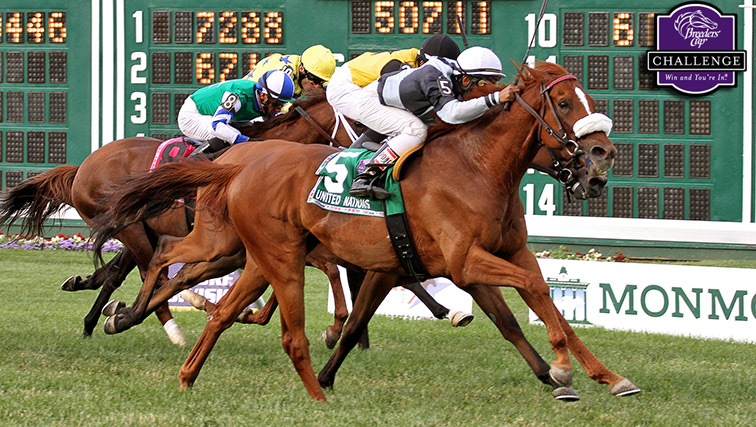Getting to Know Main Sequence

Main Sequence powered to victory in the United Nations Stakes to earn a spot in the Breeders' Cup Turf in November. (Photo by EQUI-Photo)
When Main Sequence was transferred to Graham Motion for a North American campaign, it’s doubtful his connections thought he would win a Grade 1 race right out of the gate and earn a spot in the Breeders’ Cup Turf. But that is exactly what happened when he won the $500,000 United Nations Stakes on July 5 at Monmouth Park.
Let’s take a look at the newest member of this year’s “Win and You’re In” group and see what he accomplished before he crossed over to this side of the Atlantic.
Race Résumé
Main Sequence made his debut in September of his 2-year-old year and proved to be a promising horse for the 2012 classics by winning his first four starts. His first group stakes win came at the end of that streak when he won the 2012 Derby Trial Stakes at Lingfield in his first all-weather surface start.
The result was enough to send Main Sequence to the Epsom Derby but he ran into Camelot, the top 3-year-old in Europe at the time, and finished second behind the colt by five lengths. Main Sequence didn’t find the winner’s circle again during his time in Europe but put in credible performances on the track, finishing in the top three five more times in nine starts in Europe.
The chestnut gelding was shipped to Motion with a résumé that included placings in four other group stakes races (outside of the Epsom Derby) that he had earned in 2012 and 2013.
The United Nations wasn’t Motion’s first choice for Main Sequence, but after the gelding got sick over the winter he was pointed toward the race. Main Sequence raced in the back of the field for most of the race but showed an eye-catching blast of speed to get to the front when jockey Rajiv Maragh asked him to accelerate.
UNITED NATIONS STAKES
“I spoke with David Lanigan [who previously trained Main Sequence], and in speaking to him I knew I had a lot of horse – I just had to get it out of him,” Motion said after the race. “The way he’s been working, I’ve been really anxious to run him for three or four weeks now. I think the Breeders’ Cup is now something we can consider, maybe the Arlington Million or Saratoga [next].”
Looking at Main Sequence’s 119 Equibase Speed Figure compared with others in the U.S., he should stack up well against our top grass horses. His speed figure sits atop top 10 list for all turf horses in America this year and only seven horses have run faster figures than him.
The turn of foot Main Sequence showed in the United Nations makes him an interesting addition to the turf ranks this year. While turf horses usually do their best running in the stretch, he made most of the other horses look like they were standing still when he unleashed his closing rally.
If Main Sequence does run in the Arlington Million, we will be able to get a better read on just how good he is. While the United Nations had a field of nine, overall it wasn’t the strongest field for a Grade 1 turf race in the U.S. The Arlington Million usually attracts pretty good horses both from America and abroad, which should show us a bit more about how he stacks up when it comes to becoming a serious contender for the Breeders’ Cup Turf in the fall.
Pedigree
Bred by owner Flaxman Holdings, Main Sequence was born in Kentucky.
He is by Aldebaran, who was the 2003 champion sprinter in the U.S. and the winner of the Grade 1 Metropolitan Handicap among three Grade 1 wins. Aldebaran has proved to be a useful sire with 11 stakes winners, although many of his horses have proven to be sprinters with his average winning distance sitting at 6.97 furlongs. Keep in mind that the total is boosted by a few horses like Main Sequence, who has an average winning distance in his career of 10 furlongs.
On Main Sequence’s female side, he is out of Group 3-placed Ikat, who earned that placing at one mile, although her only career win came at seven furlongs. However, looking deeper into her family, it makes sense that her son is able to run longer and has done his best running around 1 ½ miles.
Ikat’s sire, Pivotal, was a sprinter, winning from five to six furlongs, but as a sire his foals seem to be best between eight and nine furlongs, with an average winning distance of 8.16 furlongs. However, to be fair to Pivotal’s numbers, his average distance raced is 8.48 furlongs.
MAIN SEQUENCE AFTER WINNING THE UNITED NATIONS
Photo by Eclipse Sportswire
But looking at the female line of Main Sequence’s dam, it’s clear where his ability to run long came from. His grandam, Burning Sunset, is a half-sister to Shiva, who was highweighted at four and five in Europe from 9 ½ to 11 furlongs, winning the 1 3/8-mile Tattersalls Gold Cup against males in 1999. Burning Sunset also is a half-sister to Epsom Oaks winner Light Shift and Burning Sunset won at one mile and placed in a Group 2 race at 1 ¼ miles.
So, while Main Sequence has speed close up to his pedigree with his sire and dam, looking farther back on both sides (Aldebaran is by Mr. Prospector and out of a Private Account mare), one can see where his stamina comes from.
While we have only seen Main Sequence run once in the U.S., if he proves in the coming months that his United Nations was no fluke, he could be a good place to lay a few dollars on before he loads into the gate for the Breeders’ Cup Turf.
